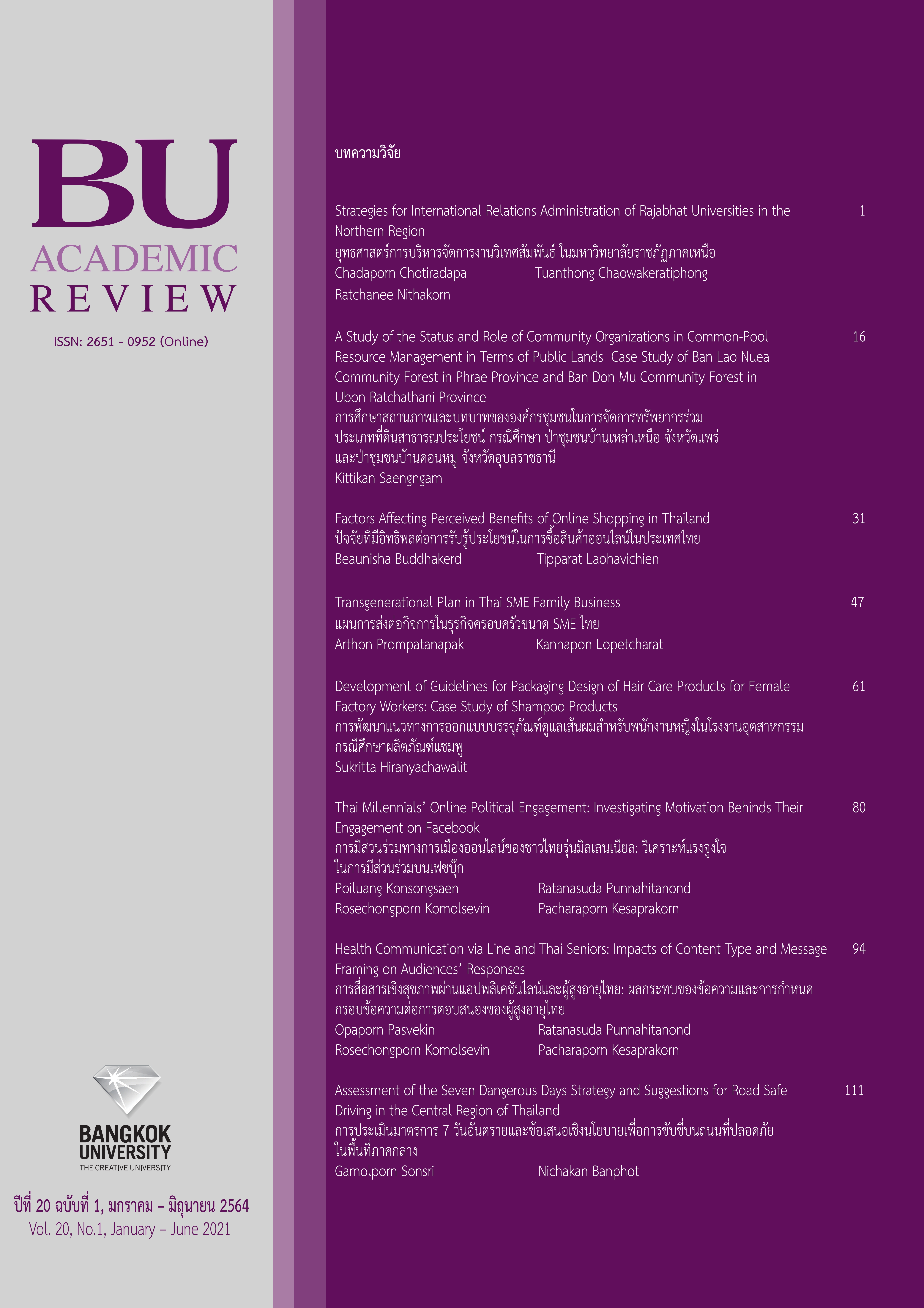Assessment of the Seven Dangerous Days Strategy and Suggestions for Road Safe Driving in the Central Region of Thailand
Main Article Content
Abstract
This study aimed to examine behaviors of road users in the central region during 7 dangerous days (28 December 2019 - 3 January 2020), using a qualitative study process emphasizing the form of implementing the measures of 7 dangerous days, considering activities based on policy tools, including law enforcement and campaigns. The study also aims at finding a relationship with productivity and short-term and medium-term outcomes in 3 risk behaviors. The results revealed as follows: 1) Drinking and driving-It could limit the number of offenders effectively by enforcing setting up of checkpoints directly and that affected the behavior of an individual. It could reduce the number of offenders on the road and caused the offenders tend not to be rearrested. In Chonburi Province, a law was enforced by setting up checkpoints near exits of various entertainment venues. The same is true for Suphan Buri Province where the checkpoints were set intensively and frequently and it could make people aware and afraid of being arrested to a certain extent; 2) Driving fast- police officers were not much strict about speed because there were a lot of travelling between cities, except for some areas, when a speed camera was installed, and there were service units set up for a certain distance. As Chonburi Province is a destination of traveling, so many travelers could not travel at high speed. As for Suphan Buri province, the road condition was good. So, many people drove at high speed and would decrease their speed when encountering speed limit signs and warning signs in speed limit areas, but this happened only for a short time, and; 3) Not wearing a helmet-There was awareness of intensity of setting up a checkpoint. In Chonburi Province, it was rare to see checking of helmets by polices. This is probably because it is a tourist province where a focus is made to drinking and driving. This makes the existing campaigns tend not to be effective in changing behavior of helmet wearing in the area. While in Suphan Buri, setting up the checkpoints affected the awareness of intensity. In this study, the recommendations are as follows: 1) the use of technology should be encouraged to fix the physical engineering that is at risk of frequent occurrences; and 2) there should be a social credit system or the social punishment added to be used in conjunction with fines in the event of dangerous or illegal driving.
Article Details
The manuscript submitted for publication must be the original version, submitted only to this particular journal with no prior acceptance for publication elsewhere in other academic journals. The manuscript must also not violate the copyright issue by means of plagiarism.
References
Dionne, G., Fluet, C., & Desjardins, D. (2007). Predicted risk perception and risk taking behavior: The case of impaired driving. Journal of Risk Uncertainty, 35(3), 237-264.
Health Information System Development Office. (2011). Yut ʻubattihēt bon thanon thūa lōk . . . phārakit phichit sōknātkam yuk mai [Stop road accidents around the world… Mission to overcome a new tragedy]. Retrieved October 9, 2020, from https://www.hiso.or.th/hiso/picture/reportHealth/tonkit31.pdf
Mayne, J. (2015). Theory of change analysis: Building robust theories of change. Canadian Journal of Program Evaluation, 32(2), 155-173.
Office of the National Economic and Social Development Council. (2017). Phǣn phatthanā phāk klāng læ phư̄nthī Krung Thēp Mahā Nakhō̜n Phō̜.Sō̜. sō̜ngphanhārō̜ihoksip - sō̜ngphanhārō̜ihoksipha [Central and Bangkok area development plan 2017 - 2022.]. Retrieved October 10, 2020, from https://www.nesdc.go.th/ewt_dl_link.php?nid =7525.
Road Safety Thailand. (2018). Sathiti ʻubattihēt thāng thanon chūang thētsakān pī mai [Road accident statistics during the new year season]. Retrieved October 11, 2020, from http://roadsafety.disaster.go.th/inner.roadsafety-1.196/download/menu_7377/#s.
Road Safety Thailand. (2019a). Rāingān sadǣng phon čhamnūan ʻubattihēt kān sīachīwit læ kān bātčhep nai chūang Songkrān [The report shows the number of accidents. Deaths and injuries during Songkran]. Bangkok: Department of Disaster Prevention and Mitigation.
Road Safety Thailand. (2019b). Phǣn mǣbot khwāmplō̜tphai thāng thanon Phō̜.Sō̜. sō̜ngphanhārō̜ihoksipʻet sō̜ngphanhārō̜ihoksipsī [Master plan, road safety articles 2018 - 2021]. Bangkok: Department of Disaster Prevention and Mitigation.
Suangka, K. (2016). Kānsưksā phrưttikam kān khapkhī khō̜ng wairun thī mī phon tō̜ khwāmsīang nai kān kœ̄t ʻubattihēt čhāk kānchai rotčhakkrayānyon [The study of teen driving behavior affects the risk of accidents from using a motorcycle]. Nakhon Ratchasima: Suranaree University of Technology.
Suchman, A. (1960). A conceptual analysis of the accident phenomenon. Social problem, 8(3), 241-253.
Thailand Development Research Institute (TDRI). (2017). Prap nǣokhit māttrakān čhet wan ʻantarāi chūang Songkrān [Adjust the concept of measures 7 days dangerous during Songkran]. Retrieved October 8, 2020, from https://www.bangkokbiznews.com/blog/detail/640859.
Thailand Road Safety Observatory. (2020a). ʻAttrā kān kœ̄t ʻubattihēt khō̜ng rotčhakkrayānyon tō̜ čhamnūan rotčhakkrayānyon čhotthabīan 10,000 khan yǣk rāi čhangwat [Motorcycle accident rate per 10,000 registered motorcycles separately by province]. Retrieved October 17, 2020, from http://trso.thairoads.org/statistic/watch/detail/159.
Thailand Road Safety Observatory. (2020b). ʻAttrā kān kœ̄t ʻubattihēt khō̜ng rotyon tō̜ čhamnūan rotyon čhotthabīan 10,000 khan yǣk rāi čhangwat [Car accidents rate per 10,000 registered cars separately by province]. Retrieved October 17, 2020, from http://trso.thairoads.org/statistic/watch/detail/160.


